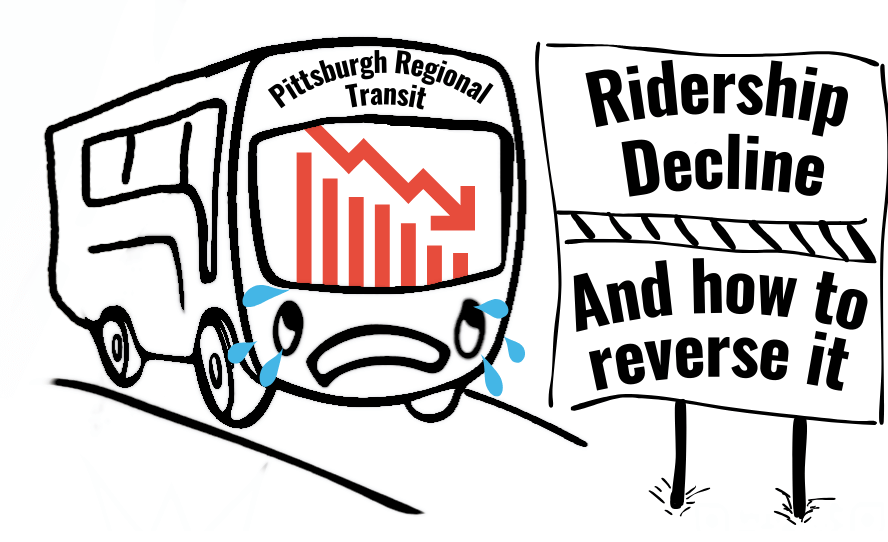Authored by the PPT Research Committee, 6/10/24

Pittsburgh’s getting national recognition, and it’s not good.
Over the last two weeks, a chart has been circulating on social media showing the change in transit ridership from 2023-2024 as we emerge from the low-point of the pandemic.
Notably, of the top 25 cities for bus ridership in the United States, all of them saw increases to transit ridership — except for Pittsburgh. (The New York City MTA is not represented on this chart, although it also saw increases to transit ridership over the past year.) On average, over the first quarter of 2024 compared to the first quarter of 2023, Pittsburgh Regional Transit (PRT) saw a daily weekday ridership drop of 9.4%.
Discouragingly, PRT CEO Katherine Kelleman seemed to play down this alarming statistic this in her May PRT Board meeting remarks, saying:
“it’s good to be noticed by transit junkies in NY…there’s been a percolating story about ridership at the top 25 properties in the US and what’s going on in Pittsburgh. Looks like we have a data anomaly…and we’re looking at a couple different scenarios on reporting and tracking, and if there’s an adjustment to be made, we’ll be coming back out… there’s some administrative stuff we’re working on.”
PRT CEO Katharine Kelleman at May 2024 PRT Board Meeting
Amy Zaiss, a member of PPT’s research committee, pulled data from PRT’s Performance Metrics portal on their website from January, February, and March of 2023 compared to the same period in 2024, and looked at ridership changes by route. This data seems to confirm the statistics shared in the Twitterverse.
Notably, 57% of the total ridership loss over that period was due to significant drops in ridership on the 61D, 71A, 71C and 71D.
All of these routes used to go to Downtown, but in October 2023, they were permanently short-turned in Oakland. These service changes were implemented despite much vocal public opposition from PPT riders and workers.
In advance of these cuts, PRT argued that riders would shift to alternative routes, including 61A, 61B, 61C, 71B. While these routes did see a total average weekday ridership gain of 1173, it didn’t make up for the short-turned routes, which saw a ridership loss of 5231 in that same time period.
Other alternative routes that were floated included the 65, 67, 69, 82 and 87, but in total ridership fell by an average of 185 riders on weekdays over those routes as well. Therefore, it’s clear from the data that riders of short-turned routes did not switch to alternate routes but instead opted for other modes of transportation.
One of the other routes that experienced the steepest ridership percentage decline over the past year was the 89, where service changes cut off the Harriet Tubman apts. In addition, the 89 route no longer services the Kingsley Association and the library. This route experienced a 27% (or 56 average daily riders) drop between 2023 and 2024.
The Takeaways: PRT needs to trust riders and workers when we say what changes will make our transit worse. We’re calling for PRT to reverse the cuts on the 61 & 71s and proceed carefully with the “Bus Line Redesign” to increase ridership.
Our region needs a transit system that grows service and ridership, one that should be an outlier in positive ways. We believe that Allegheny County can be a national leader with a vision and a plan for ridership growth.
Last year, hundreds of bus riders and workers spoke up with concerns about the impact of the 61 and 71 bus short-turns on the Downtown to Oakland Bus Rapid Transit corridor and called for PRT to amend its plan. With this data in hand, we call on PRT to reverse these harmful cuts and restore the direct connections between communities in the East End and Homestead to Uptown and Downtown.
As PRT continues with its bus line redesign, they must listen to riders and workers in decision-making around service changes because they are experts in their own needs and experiences. The bus short-turns in Oakland prove what the data already shows: riders prefer reliable schedules and 1-seat rides. According to PRT’s 2015 rider survey, 80% of riders don’t require a transfer when using the route they ride most often. The transit network has existed roughly in the same layout for decades. People have chosen where they live, work, and spend time with their friends and family based on this network. The haphazard plan to change some of the largest routes by ridership should be a signal to PRT to approach the Bus Network Redesign with a do-no-harm approach.
However, right now PRT wants a Bus Network Redesign plan to be cost-neutral, leaving some communities to gain better transit at the expense of others. While the plan is still in development, changes to the network will cause further disruptions and schedule unreliability, making it difficult for riders to plan their trips. Over the past year, this has severely hurt ridership levels.
PRT must not let this happen again. We need a bigger vision for the Bus Line Redesign, one that expands service and access to transit for all of Allegheny County. Even PRT’s most ambitious network redesign scenario only proposes an increase in service by 10%, which is less service than we had in pre-pandemic times.
We call on PRT to lead the charge by re-imagining what’s possible. They need to be more proactive with advocating for funds and develop strategies to regain ridership. They need to fix schedules and create real goals and metrics to hire workers. Most importantly, they need to put riders and workers at the forefront of their plans.